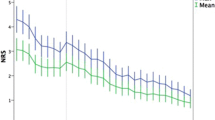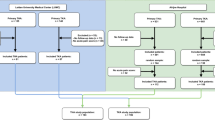Abstract
Purpose
The aim of this study was to explore acute movement-evoked postoperative pain intensity trajectories over the first 5 days after total hip arthroplasty (THA) and to examine how these pain trajectories are associated with pain-related outcomes 6 weeks and 6 months later.
Methods
A total of 150 adult patients [72 women (48.0 %); mean age 60.0 ± 9.2 (standard deviation) years] completed pain questionnaires preoperatively, several times daily postoperatively until hospital discharge, and 6 weeks and 6 months after surgery.
Results
Results showed that the best model had four different acute postoperative pain trajectories and a significant quadratic term. The trajectories varied in terms of initial pain intensity levels and rates of decline/increase in pain over the first 4 postoperative days. Significant predictors of pain trajectory membership were preoperative pain disability and anxiety as well as cumulative morphine consumption 24 h following surgery. Pain trajectories were significantly associated with levels of pain intensity and anxiety at 6 weeks but not at 6 months postoperatively.
Conclusion
This study showed that during the postoperative period patients differed in terms of pain intensity profiles and that these differences were associated with outcomes for up to 6 weeks following surgery. Pain trajectories were not predictive of persistent postoperative pain status at 6 months. Nonetheless, these results highlight the importance of patient heterogeneity in acute postoperative pain and pain-related outcomes months after THA.



Similar content being viewed by others
References
Canadian Joint Replacement Registry (CJRR). 2006 CJRR report: total hip and total knee replacements in Canada. Canadian Institute for Health Information, Ottawa. 2006. Available at: https://secure.cihi.ca/estore/productSeries.htm?pc=PCC51
Nwachukwu BU, McCormick F, Provencher MT, Roche M, Rubash HE. A comprehensive analysis of medicare trends in utilization and hospital economics for total knee and hip arthroplasty from 2005 to 2011. J Arthroplasty. 2015;30(1):15–8.
Beswick AD, Wylde V, Gooberman-Hill R, Blom A, Dieppe P. What proportion of patients report long-term pain after total hip or knee replacement for osteoarthritis? A systematic review of prospective studies in unselected patients. BMJ Open. 2012;2(1):e000435.
Werner MU, Kongsgaard UEI. Defining persistent post-surgical pain: is an update required? Br J Anaesth. 2014;113(1):1–4.
Katz J, Seltzer Z. Transition from acute to chronic postsurgical pain: risk factors and protective factors. Exp Rev Neurother. 2009;9(5):723–44.
Katz J, Jackson M, Kavanagh BP, Sandler AN. Acute pain after thoracic surgery predicts long-term post-thoracotomy pain. Clin J Pain. 1996;12(1):50–5.
Perkins FM, Kehlet H. Chronic pain as an outcome of surgery. A review of predictive factors. Anesthesiology. 2000;93(4):1123–33.
Katz J. One man’s risk factor is another man’s outcome: difference in risk factor profiles for chronic postsurgical pain maintenance vs transition. Pain. 2012;153(3):505–6.
Clarke H, Kay J, Mitsakakis N, Katz J. Acute pain after total hip arthroplasty does not predict the development of chronic postsurgical pain 6 months later. J Anesth. 2010;24(4):537–43.
Chapman CR, Donaldson GW, Davis JJ, Bradshaw DH. Improving individual measurement of postoperative pain: the pain trajectory. J Pain. 2011;12(2):257–62.
Lavand’homme P. The progression from acute to chronic pain. Curr Opin Anaesthesiol. 2011;24(5):545–50.
Bonnet A, Lavand’homme P, France M-N, Reding R, De Kock M. Identification du risque de douleur chronic après hépatectomie pour don de foie par les trajectoires de douleur. Ann Fr Anesth Réanim. 2012;31:945–9.
Bellamy N, Buchanan WW. A preliminary evaluation of the dimensionality and clinical importance of pain and disability in osteoarthritis of the hip and knee. Clin Rheumatol. 1986;5(2):231–41.
Bellamy N. WOMAC osteoarthritis Index user guide. Version VII. Brisbane, Australia; 2005. http://www.womac.org/womac/womac_userguide.htm
Bellamy N, Buchanan WW, Goldsmith CH, Campbell J, Stitt LW. Validation study of WOMAC: a health status instrument for measuring clinically important patient relevant outcomes to antirheumatic drug therapy in patients with osteoarthritis of the hip or knee. J Rheumatol. 1988;15(12):1833–40.
Roos EM, Klassbo M, Lohmander LS. WOMAC osteoarthritis index. Reliability, validity, and responsiveness in patients with arthroscopically assessed osteoarthritis. Western Ontario and MacMaster Universities. Scand J Rheumatol. 1999;28(4):210–5.
Dunbar MJ, Robertsson O, Ryd L, Lidgren L. Appropriate questionnaires for knee arthroplasty. Results of a survey of 3600 patients from The Swedish Knee Arthroplasty Registry. J Bone Joint Surg Br. 2001;83(3):339–44.
McConnell S, Kolopack P, Davis AM. The Western Ontario and McMaster Universities Osteoarthritis Index (WOMAC): a review of its utility and measurement properties. Arthritis Rheum. 2001;45(5):453–61.
Wright JG, Young NL. A comparison of different indices of responsiveness. J Clin Epidemiol. 1997;50(3):239–46.
Brazier JE, Harper R, Munro J, Walters SJ, Snaith ML. Generic and condition-specific outcome measures for people with osteoarthritis of the knee. Rheumatology (Oxford). 1999;38(9):870–7.
Roos EM, Roos HP, Lohmander LS. WOMAC Osteoarthritis Index—additional dimensions for use in subjects with post-traumatic osteoarthritis of the knee. Western Ontario and MacMaster Universities. Osteoarthr Cartil. 1999;7(2):216–21.
Bombardier C, Melfi CA, Paul J, Green R, Hawker G, Wright J, et al. Comparison of a generic and a disease-specific measure of pain and physical function after knee replacement surgery. Med Care. 1995;33[4 Suppl]:AS131–44.
Bullens PH, van Loon CJ, de Waal Malefijt MC, Laan RF, Veth RP. Patient satisfaction after total knee arthroplasty: a comparison between subjective and objective outcome assessments. J Arthroplasty. 2001;16(6):740–7.
Robertsson O, Dunbar MJ. Patient satisfaction compared with general health and disease-specific questionnaires in knee arthroplasty patients. J Arthroplasty. 2001;16(4):476–82.
Pollard CA. Preliminary validity study of the pain disability index. Percept Mot Skills. 1984;59(3):974.
Tait RC, Pollard CA, Margolis RB, Duckro PN, Krause SJ. The Pain Disability Index: psychometric and validity data. Arch Phys Med Rehabil. 1987;68(7):438–41.
Chibnall JT, Tait RC. The Pain Disability Index: factor structure and normative data. Arch Phys Med Rehabil. 1994;75(10):1082–6.
Tait RC, Chibnall JT. Factor structure of the pain disability index in workers compensation claimants with low back injuries. Arch Phys Med Rehabil. 2005;86(6):1141–6.
Dworkin RH, Turk DC, Farrar JT, Haythornthwaite JA, Jensen MP, Katz NP, et al. Core outcome measures for chronic pain clinical trials: IMMPACT recommendations. Pain. 2005;113(1–2):9–19.
Bjelland I, Dahl AA, Haug TT, Neckelmann D. The validity of the Hospital Anxiety and Depression Scale. An updated literature review. J Psychosom Res. 2002;52(2):69–77.
Zigmond AS, Snaith RP. The hospital anxiety and depression scale. Acta Psychiatr Scand. 1983;67(6):361–70.
Clarke H, Pagé MG, McCartney C, Huang A, Stratford P, Andrion J, et al. Pregabalin reduces postoperative opioid consumption and pain for 1 week after hospital discharge, but does not affect function at 6 weeks or 3 months after total hip arthroplasty. Br J Anaesth. 2015;115(6):903–11.
Asparouhov T, Muthen B. Multilevel mixture models. In: Hancock GR, Samuelsen KM, editors. Advances in latent variable mixture models. Charlotte: Information Age Publishing Inc; 2008. p. 27–51.
Muthen B, Asparouhov T. Growth mixture modeling: analysis with non-Gaussian random effects. In: Fitzmaurice G, Davidian M, Verbeke G, Molenberghs G, editors. Longitudinal data analysis. Boca Raton:Chapman & Hall/CRC Press; 2009. p. 143–165.
Muthen B, Shedden K. Finite mixture modeling with mixture outcomes using the EM algorithm. Biometrics. 1999;55:463–9.
Proust-Lima C, Philipps V, Diakite A, Liquet B. lcmm: estimation of latent class mixed models, joint latent class mixed models and mixed models for curvilinear outcomes. R package version 1632013. https://cran.r-project.org/web/packages/lcmm/lcmm.pdf
Team RC. R: A language and environment for statistical computing. Vienna: R Foundation for Statistical Computing; 2013.
Akaike H. Information measures and model selection. Bull Int Stat Inst. 1983;44:277–91.
de Leeuw J. Introduction to Akaike (1973) information theory and an extension of the maximum likelihood principle. In: Kotz S, Johnson NL, editors. Breakthrough in statistics, vol. 1. London: Springer; 1992. p. 599–609.
Lord FM, Novick MR. Statistical theories of mental test scores. Reading: Addison-Wesley; 1968.
Ram N, Grimm KJ. Growth mixture modeling: a method for identifying differences in longitudinal change among unobserved groups. Int J Behav Dev. 2009;33(6):565–76.
Curran PJ, Obeidat K, Losardo D. Twelve frequently asked questions about growth curve modeling. J Cogn Dev. 2010;11(2):121–36.
Hertzog C, Lindenberger U, Ghisletta P, Oertzen T. On the power of multivariate latent growth curve models to detect correlated change. Psychol Methods. 2006;11(3):244–52.
Steyaert A, De Kock M. Chronic postsurgical pain. Curr Opin Anaesthesiol. 2012;25(5):584–8.
Liu SS, Buvanendran A, Rathmell JP, Sawhney M, Bae JJ, Moric M, et al. Predictors for moderate to severe acute postoperative pain after total hip and knee replacement. Int Orthop. 2012;36(11):2261–7.
Pinto PR, McIntyre T, Ferrero R, Almeida A, Araujo-Soares V. Predictors of acute postsurgical pain and anxiety following primary total hip and knee arthroplasty. J Pain. 2013;14(5):502–15.
Althaus A, Arranz Becker O, Neugebauer E. Distinguishing between pain intensity and pain resolution: using acute post-surgical pain trajectories to predict chronic post-surgical pain. Eur J Pain. 2014;18(4):513–21.
Page MG, Katz J, Romero Escobar EM, Lutzky-Cohen N, Curtis K, Fuss S, et al. Distinguishing problematic from nonproblematic postsurgical pain: a pain trajectory analysis after total knee arthroplasty. Pain. 2015;156(3):460–8.
Santaguida PL, Hawker GA, Hudak PL, Glazier R, Mahomed NN, Kreder HJ, et al. Patient characteristics affecting the prognosis of total hip and knee joint arthroplasty: a systematic review. Can J Surg. 2008;51(6):428–36.
Clarke H, Poon M, Weinrib A, Katznelson R, Wentlandt K, Katz J. Preventive analgesia and novel strategies for the prevention of chronic post-surgical pain. Drugs. 2015;75(4):339–51.
Haroutiunian S, Nikolajsen L, Finnerup NB, Jensen TS. The neuropathic component in persistent postsurgical pain: a systematic literature review. Pain. 2013;154(1):95–102.
Acknowledgments
MGP is supported by a Canada Graduate Scholarship—Postdoctoral Fellowship from the Canadian Institutes of Health Research (CIHR). JK is supported by a CIHR Canada Research Chair in Health Psychology at York University. HC is supported by a Merit Award from the Department of Anesthesia at the University of Toronto. The data collection was enabled by a Pfizer Canada physician-initiated peer-reviewed Neuropathic Pain Competition award.
Author information
Authors and Affiliations
Corresponding author
Ethics declarations
Conflict of interest
The authors have no conflicts of interest.
About this article
Cite this article
Pagé, M.G., Katz, J., Curtis, K. et al. Acute pain trajectories and the persistence of post-surgical pain: a longitudinal study after total hip arthroplasty. J Anesth 30, 568–577 (2016). https://doi.org/10.1007/s00540-016-2183-4
Received:
Accepted:
Published:
Issue Date:
DOI: https://doi.org/10.1007/s00540-016-2183-4




